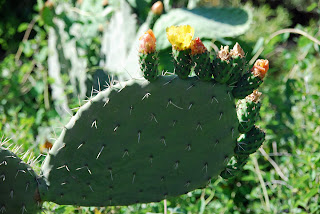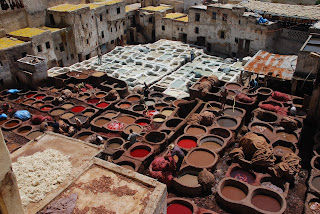Sahara: Dunes & Dromedaries

Two of us were missing. We were going to have to leave them behind. Perhaps they were hopelessly lost in the maze of alleys that make up the Marrakech medina. Or maybe, like thousands of others, the erupting Icelandic volcano had cruelly interrupted their trip. That they would choose not to show up is unimaginable. Still, we had delayed our departure for more than an hour and we had to move on. So began the most memorable stretch of the Great Odyssey (so far).
I awoke that morning at 5 a.m. It was a full two hours earlier than necessary, but I was far too excited to sleep. I hadn’t stopped thinking about it since the email from Omar popped onto my iPhone screen, confirming my spot on the excursion. Even if I had wanted to sleep a little longer, those damn chirping birds in the Dar Balthazar courtyard weren’t about to allow it. So, at 7 a.m. I ducked through the Hobbit-sized front door into the cobbled alleyway of Bab Doukkala, leaving behind yet another opulently decorated riad, where I’d stayed relatively cheaply since my return to the Red City from Essaouira. It was a brisk start to the day, much like an October morning in Las Vegas, but that wouldn’t last. As the sun rose high in the sky, so too did the heat. I strapped on my 45 lb pack and launched out on the 2 km hike to the far side of Jemaa el Fna, Marrakech’s main square, where I was to meet my fellow travelers Dorinda, Ninka, and Tabitha from the Netherlands, Kate from NY, and our guide Youseff. We were headed to the desert, to the Sahara!
My Desert Hotel
First we’d have to cross 600 kilometers of mountainous terrain to get to the Saharan dunes of Erg Chebbi which is in eastern Morocco near the conflict-closed border with Algeria. Between Marrakech and our destination lay the snow capped High Atlas Mountains and the stunning gorges, fertile valleys and oases that lay immediately to their east.
Youseff, our Guide
The High Atlas Mountains
In the distance, we could see the Atlas range rise sharply from the rocky plains that surround the city. Unfinished cinder block housing projects and dying scrub grass aren’t much to look at so I was happy when the evergreen and poplar forests of the foothills began to appear. Valleys began to fill with the unmistakable silver-green flash of olive trees, rimmed with yellow flowering prickly pear (which brought to mind the countless unfortunate encounters I’d seen poor Wile E Coyote endure with that cactus, in my youth.)
As we climbed higher into the mountains, sweeping ridges appeared in a remarkable variety of colours of earth and stone. Cinnamon brown and earthen red Kasbahs and ancient-looking Berber villages clung to steepening slopes, with their terraced croplands haloing villages in patchwork green.
Heading Through the Pass
The French Foreign Legion completed the Tizi-n-Tichka pass through these mountains in the mid 1930’s. It must have been a harrowing job to work on. My ears popped as the 4x4 wound and looped its way to our peak altitude of 7,415 feet, still far below the 13,667 of nearby Mont Toubkal. With every turn, a breathtaking new vista appeared. Looking back over sheer cliffs at our hairpin route I felt the dizziness set in. This feeling was intensified by precipitous drop-offs hugging barely protected corners of blacktop and the ever-present threat that we’d turn a blind corner and tragically hurtle through a wayward flock of sheep lounging in the middle of the roadway.
Immediately after the pass, as we started to descend down the eastern slope of the High Atlas, the landscape turned arid, an early promise of what we were to find when we reached our destination. Heading northeast now, we stopped briefly at Aït Benhaddou. This magnificent looking Ksar (fortified village) is a UNESCO protected site that has starred in many films over the years including, most famously, Lawrence of Arabia. Continuing on, we passed Ouarzazate (Wahr za zat), the gateway city to the Sahara, and the Moroccan ‘Hollywood’. Our 4x4 briefly veered off road and as we crested a hill, Atlas Studios came into view on the desert floor, with its larger-than-life film props piled deep against studio walls. This is where Kingdom of Heaven, Last Temptation of Christ, Gladiator, The Mummy, Jewel of the Nile and others were filmed.
Aït Benhaddou
Dadès Gorge
More driving, more gorges, and finally in the afternoon of the second day we reached Erg Chebbi. I thoroughly enjoyed the spectacular trip through the Atlas, but was thrilled to finally climb atop my camel.
The reality of the Sahara is, not surprisingly, much less romantic than the ludicrous visions that pop culture had attempted to forge in my mind. Still, all folklore has some of its roots in fact, and that was sufficient for me. For thousands of years, great trading caravans have traversed this desert bringing gold, silver, spices, and slaves to and from Northwest Africa for trafficking to Europe and beyond. Much like our small group, the caravans of ancient times were led by camel pullers charged with navigating the merciless desert and safely shepherding camel trains of up to 10,000 beasts to water and their final destinations. While I failed to discover any lost cities of gold, I was not the least bit disappointed with my excursion.
I was struck by the absolute silence of the desert. Beyond the odd snort (or other bodily function) emitted by our sturdy dromedaries, or the nearly imperceptible shuffling of hooves on sand, there was no sound. Even my fellow trekkers were oddly quiet. Perhaps, like me, they were immersed in the moment – absorbing the remarkable terrain, the sweeping dunes and the perfect sand curves that would excite even the most jaded mathematician. For two hours following the hold-on-for-dear-life forward and backward lurching that occurred as my ride got on its feet, our barefoot Berber guide led us up, down and around the dunes, navigating us along crests where one wrong step could send us tumbling camel-over-rider down sandy embankments.
Erg Chebbi, Sahara Desert
Unlike the camel-riders of old, I had climbed atop my trusty steed for pleasure, not necessity. After a couple of hours (ten minutes, actually) I had no problem understanding that the act of riding such a beast for any length of time is only reasonable in times of necessity. Comfortable, they are not.
The trip to our camp was everything I had hoped it would be. After a little stretching and some mint tea with the others, we climbed the 900-foot dune rising behind our tent to watch the sunset change sand from pink to brilliant orange-red for as far as the eye could see. It was like a scene from a movie. It won’t come as a surprise that in the desert, there are an infinite number of stars. After a couple hours lounging in the sand, gazing upon those stars, dining on camp-cooked Tajine, and listening to the tribal drumming of our Berber hosts, I faded off to sleep.
Our Berber Hosts
There is more to this story beyond the return camel ride to rendezvous with our driver and the long trek back, but perhaps I will keep some parts of the Great Odyssey just for myself. It did occur to me though, as we wheeled across lands still traveled by desert nomads, that right now I’m not completely different from them. Like the nomads, I am (for the first time in my life) completely at liberty, with no permanent home to call my own -- a Canadian at Liberty...




















Can't wait to see more pics and hear more stories!
ReplyDeletebeautiful
ReplyDeleteThat looks absolutely cool, buddy!
ReplyDeleteCraig, not sure what's better - your pics or your story!!!! I enjoy reading your blog!
ReplyDeleteI agree with Tijana .... Your writing and your visuals are equally amazing!! I look forward to reading your blogs more than most other available options ..... keep sharing and keep enjoying!! Travel safe.
ReplyDeleteWhat a great read! Maybe there is an alternate vocation doing this for the rest of your life. I don't know how you find time to write. When you get to Europe all will seem so civilized. Regards
ReplyDeleteUNC
Hey, if the parts you left out had anything to do with those Dutch girls, say no more chief (wink wink, nudge nudge). BTW, nothing has changed here, other than gas went up $0.05's last night....so make it last and don't hurry home.
ReplyDeleteb
Wonderful, enjoyable reading!
ReplyDeleteWhat am I going to look forward to, when you return to our civilization?
C.J.
Thanks Little Bro. If I was 15 years younger, who knows, but as it happened all participants were well behaved. Sorry to disappoint ;-)
ReplyDeleteLoved reading about your journey thru the desert!
ReplyDeleteI made it thru the Atlas Mountains last year but did not continue onward. Now, after reading your post, I am eager to go back for a journey thru the dunes.